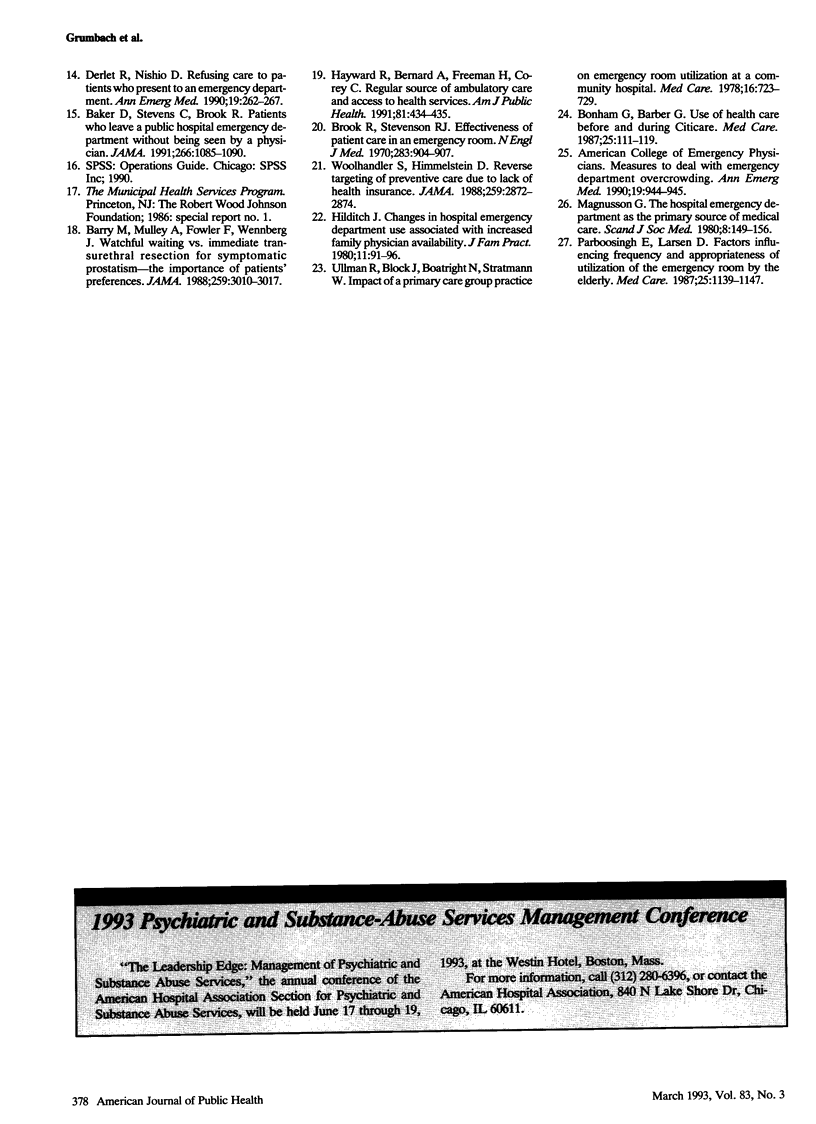Abstract
OBJECTIVES. Our objective was to evaluate whether referral to primary care settings would be clinically appropriate for and acceptable to patients waiting for emergency department care for nonemergency conditions. METHODS. We studied 700 patients waiting for emergency department care at a public hospital. Access to alternative sources of medical care, clinical appropriateness of emergency department use, and patients' willingness to use nonemergency services were measured and compared between patients with and without a regular source of care. RESULTS. Nearly half (45%) of the patients cited access barriers to primary care as their reason for using the emergency department. Only 13% of the patients waiting for care had conditions that were clinically appropriate for emergency department services. Patients with a regular source of care used the emergency department more appropriately than did patients without a regular source of care. Thirty-eight percent of the patients expressed a willingness to trade their emergency department visit for an appointment with a physician within 3 days. CONCLUSIONS. Public emergency departments could refer large numbers of patients to appointments at primary care facilities. This alternative would be viable only if the availability and coordination of primary care services were enhanced for low-income populations.
Full text
PDF






Selected References
These references are in PubMed. This may not be the complete list of references from this article.
- Andrulis D. P., Kellermann A., Hintz E. A., Hackman B. B., Weslowski V. B. Emergency departments and crowding in United States teaching hospitals. Ann Emerg Med. 1991 Sep;20(9):980–986. doi: 10.1016/s0196-0644(05)82976-2. [DOI] [PubMed] [Google Scholar]
- Baker D. W., Stevens C. D., Brook R. H. Patients who leave a public hospital emergency department without being seen by a physician. Causes and consequences. JAMA. 1991 Aug 28;266(8):1085–1090. [PubMed] [Google Scholar]
- Barry M. J., Mulley A. G., Jr, Fowler F. J., Wennberg J. W. Watchful waiting vs immediate transurethral resection for symptomatic prostatism. The importance of patients' preferences. JAMA. 1988 May 27;259(20):3010–3017. [PubMed] [Google Scholar]
- Bindman A. B., Grumbach K., Keane D., Rauch L., Luce J. M. Consequences of queuing for care at a public hospital emergency department. JAMA. 1991 Aug 28;266(8):1091–1096. [PubMed] [Google Scholar]
- Bonham G. S., Barber G. M. Use of health care before and during Citicare. Med Care. 1987 Feb;25(2):111–119. doi: 10.1097/00005650-198702000-00004. [DOI] [PubMed] [Google Scholar]
- Brook R. H., Stevenson R. L., Jr Effectiveness of patient care in an emergency room. N Engl J Med. 1970 Oct 22;283(17):904–907. doi: 10.1056/NEJM197010222831705. [DOI] [PubMed] [Google Scholar]
- Buesching D. P., Jablonowski A., Vesta E., Dilts W., Runge C., Lund J., Porter R. Inappropriate emergency department visits. Ann Emerg Med. 1985 Jul;14(7):672–676. doi: 10.1016/s0196-0644(85)80886-6. [DOI] [PubMed] [Google Scholar]
- Davidson S. M. Understanding the growth of emergency department utilization. Med Care. 1978 Feb;16(2):122–132. doi: 10.1097/00005650-197802000-00004. [DOI] [PubMed] [Google Scholar]
- Derlet R. W., Nishio D. A. Refusing care to patients who present to an emergency department. Ann Emerg Med. 1990 Mar;19(3):262–267. doi: 10.1016/s0196-0644(05)82041-4. [DOI] [PubMed] [Google Scholar]
- Haddy R. I., Schmaler M. E., Epting R. J. Nonemergency emergency room use in patients with and without primary care physicians. J Fam Pract. 1987 Apr;24(4):389–392. [PubMed] [Google Scholar]
- Hayward R. A., Bernard A. M., Freeman H. E., Corey C. R. Regular source of ambulatory care and access to health services. Am J Public Health. 1991 Apr;81(4):434–438. doi: 10.2105/ajph.81.4.434. [DOI] [PMC free article] [PubMed] [Google Scholar]
- Hilditch J. R. Changes in hospital emergency department use associated with increased family physician availability. J Fam Pract. 1980 Jul;11(1):91–96. [PubMed] [Google Scholar]
- Magnusson G. The hospital emergency department as the primary source of medical care. Scand J Soc Med. 1980;8(3):149–156. doi: 10.1177/140349488000800311. [DOI] [PubMed] [Google Scholar]
- Pane G. A., Farner M. C., Salness K. A. Health care access problems of medically indigent emergency department walk-in patients. Ann Emerg Med. 1991 Jul;20(7):730–733. doi: 10.1016/s0196-0644(05)80832-7. [DOI] [PubMed] [Google Scholar]
- Parboosingh E. J., Larsen D. E. Factors influencing frequency and appropriateness of utilization of the emergency room by the elderly. Med Care. 1987 Dec;25(12):1139–1147. doi: 10.1097/00005650-198712000-00003. [DOI] [PubMed] [Google Scholar]
- SHORTLIFFE E. C., HAMILTON T. S., NOROIAN E. H. The emergency room and the changing pattern of medical care. N Engl J Med. 1958 Jan 2;258(1):20–25. doi: 10.1056/NEJM195801022580105. [DOI] [PubMed] [Google Scholar]
- Schneider K. C., Dove H. G. High users of VA emergency room facilities: are outpatients abusing the system or is the system abusing them? Inquiry. 1983 Spring;20(1):57–64. [PubMed] [Google Scholar]
- Schroeder S. A. The increasing use of emergency services: Why has it occurred? Is it a problem? West J Med. 1979 Jan;130(1):67–69. [PMC free article] [PubMed] [Google Scholar]
- Shesser R., Kirsch T., Smith J., Hirsch R. An analysis of emergency department use by patients with minor illness. Ann Emerg Med. 1991 Jul;20(7):743–748. doi: 10.1016/s0196-0644(05)80835-2. [DOI] [PubMed] [Google Scholar]
- Stewart A. L., Hays R. D., Ware J. E., Jr The MOS short-form general health survey. Reliability and validity in a patient population. Med Care. 1988 Jul;26(7):724–735. doi: 10.1097/00005650-198807000-00007. [DOI] [PubMed] [Google Scholar]
- Stratmann W. C., Ullman R. A study of consumer attitudes about health care: the role of the emergency room. Med Care. 1975 Dec;13(12):1033–1043. doi: 10.1097/00005650-197512000-00005. [DOI] [PubMed] [Google Scholar]
- Ullman R., Block J. A., Boatright N. C., Stratmann W. C. Imapct of a primary care group practice on emergency room utilization at a community hospital. Med Care. 1978 Sep;16(9):723–729. doi: 10.1097/00005650-197809000-00002. [DOI] [PubMed] [Google Scholar]
- Ullman R., Block J. A., Stratmann W. C. An emergency room's patients: their characteristics and utilization of hospital services. Med Care. 1975 Dec;13(12):1011–1020. doi: 10.1097/00005650-197512000-00003. [DOI] [PubMed] [Google Scholar]
- Woolhandler S., Himmelstein D. U. Reverse targeting of preventive care due to lack of health insurance. JAMA. 1988 May 20;259(19):2872–2874. [PubMed] [Google Scholar]


